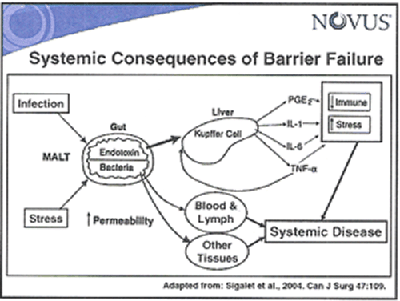



Gut Management, Microbiota and Enteric Disease
By Chris Harris, Senior Editor ThePoultrySite. The bacterial population of the gut in poultry is affected by what the bird is fed. |
| Dr Julia Dibner |
In the Novus sponsored annual SPSS annual luncheon presentation during the International Poultry Scientific Forum in Atlanta, Dr Julia Dibner, senior scientist at Novus, showed how the digestive system structure and function of chickens can be affected by feed and stress in the gut.
She said that the structure of the intestine, the feed and digesta, the gut associated immune system and the gut microflora were all variables that had to be taken into consideration in gut management for healthy poultry.
Dr Dibner showed how the bacterial population of the digestive tract and the pH changes along the tract.
The start of the tract is acid tolerant with a pH of between 3 and 5, with a bacterial density of between 103 and 105 cfu/g in the crop gizzard and duodenum and with the main species of bacteria being acid tolerant lactobacilli. Further along the tract into the small intestine, the acidity changes to a pH of between 6.5 and 7.5 and the bacterial density increases to between 108 and 109. The main bacterial species are lactobacilli, clostridia, streptococcus and enterococcus. At the distal the pH rises to more than pH7 and the bacterial density increases to 1010 to 1012 and the microbial population are anerobes with the main species clostridia, fusibacteria, lactobacilli, bacteroide, coliforms and faecal strep.
By the time the food has reached the ceca in the tract, most of the nutrients have gone, but it is because of this balance of acidity and bacteria that the content of the feed can affect the bacterial content of the tract.
One important aspect of the feed is the dietary quality of the fat.
Dr Dibner showed that Dietary oxidise fat is a source of oxidative stress and this can be from poorly preserved fat and animal by products and inadequate dietary antioxidants, whether synthetic or natural.
She said that some of the oxidised dietary components are absorbed but endogenous antioxidants can be overwhelmed.
 |
Dr Dibner showed how the cell structure in the small intestine is a continually renewing processes, with cells moving up the intestinal villi during their lifespan. By evaluating the lifespan of the cells in the gut, she said it is possible to evaluate the stress to the gut.
Oxidised cells have a shorter half life than non-oxidised cells.
In a healthy gut the tips of the villi are intact but where there has been no antioxidant, the tips of the villi become frayed. The immune system of the gut becomes affected by the oxidised fat and this has an effect on the microflora in the gut, with an increase in e.coli and a reduction in lactobacilli.
However, she said that there are a lot of dietary variables that can change the bacterial populations.
Dr Dibner added that there were treatments and dietary supplements that could change the bacterial population make-up. For instance she showed that tests had indicated that BMD treatments could result in more lactobacilli and Organic Acid Blends such as Activate® could result in more commensal clostridia and enterococci.
Subclinical enteritis, an inflammation of the mucous membrane, is a general response to a variety of insults, whether they are from bacteria, viruses, mild parasitic infections or toxins. Enteritis causes increased mucous secretion and in testinal fluid and the condition can be associated with Clostridium perfringens dysbacteriosis.
When subclinical enteritis occurs, it can disrupt the barrier function in the gut and bacteria can invade the intestinal tissue. This occurs through the ragged tips of the Villi. The way the bacteria move and the increased activity can be associated with lack of enteral feeding.
 |
Dr Dibner concluded that gut health in poultry directly impacts performance efficiency in the bird and nutrition is the key to gut health. She said it is one of the few things that can be controlled through nutrition, because what is fed to the chickens can be controlled.
She said that there are many causes to intestinal stress although they are rarely identified, but the intestine has a limited number of responses to stress. Subclinical enterisis with mucus secretion is an innate immune response while Clostridium Perfringens dysbacteriosis is an important variable.
However, stress can also cause barrier failure and this will lead to a systemic distribution of various pathogens. February 2008











